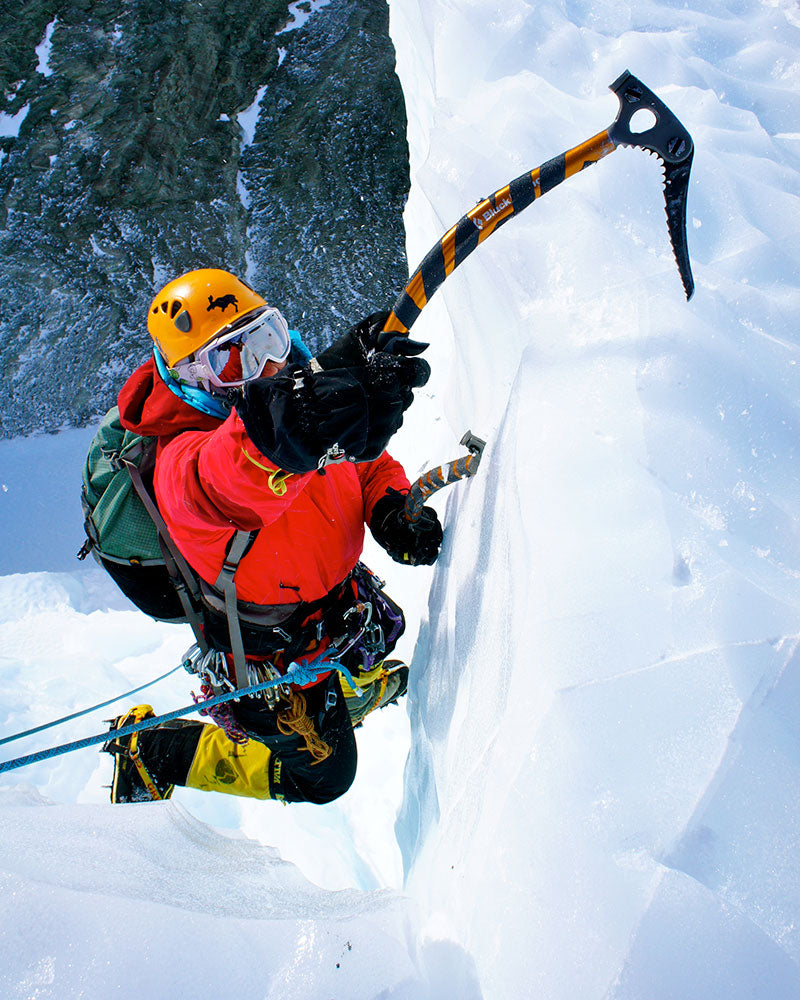
Why We Ascend
At NEMO, mountaineering is in our blood.
We design equipment to make it easier for people to pursue their alpine adventures. We are passionate about it. We do it with the spirit of the great artisans that approach their craft with pride. But we also do it because the mountains are where we repair when our time is free.
But why? What are the reasons we risk our safety and comfort to visit the alpine heights? Sir George Mallory seemed to think it was self-evident. “Because it’s there,” he famously quipped to a reporter when on a tour raising money for an expedition to Mt. Everest.
While this quote expresses the childlike whimsy of mountaineering, the casual courage required to encounter danger for the pure fun of it, it is not exactly a comprehensive explanation. The truth is, the reasons we seek the mountains are personal, diverse and sometimes contradictory.
Mountains Reveal Character
Mountaineering can offer a personal test, an inner exploration of your capacities and limits.
“Climbing offers a series of mental and physical challenges played out in some of the most beautiful places on our planet,” says Alpine Guide Rich Meyer. “Overcoming those challenges, feeling a sense of accomplishment, and learning a little more about yourself is tremendously rewarding.”
Some psychologists argue the mountain itself is incidental to the mountaineer, that instead the individual uses the mountain to test his or her physical and mental limits. According to psychologist Mike Leveheugen, mountaineers seek the high-risk environment of the mountains to prove something about themselves or to others.
“The deeper the pressure, the more their character is revealed,” he says.
Sir Edmund Hillary, the first person to ever climb Mt. Everest also saw his mountaineering feats as a personal journey.
“It’s not the mountain we conquer, but ourselves."
Climbing as Meditation
A friend of mine portrays mountaineering as a shortcut to zen. He’s not alone. Many say the complete and undivided attention required in aspects of mountaineering excludes distracting or persistent thoughts.
“This activity is similar to meditation because you need to be very present in the moment to be safe and successful,” says psychologist Jennifer Leigh. “You are focusing on what you are doing and not worrying about the past or the future.”
This requirement can act as a salve to those seeking presence or clarity of thought.

Solitude
The annals of mankind has no shortage of tales involving people retreating to the mountains in quest of a rich sense of solitude. Wise mountain sages, world weary rebels or poets in quest of inspiration and communion with natural rhythms fill our history books and literary history.
“Great things are done when men and mountains meet,” wrote the poet William Blake. “This is not done by jostling in the street.”
This hunt for solitude has perhaps been never more essential than in the present age, with the dominance of digital screens, hyperconnection and the enhanced speed and need of communication. The mountains, with their relative calm and quiet are a huge allure for the introverts and burn-outs among us.
“Meaningful alonetime, it turns out, is a powerful need and a necessary tonic in today's rapid-fire world,” writes psychologist Esther Buchholz.
A Bigger, Broader Picture
Mountain peaks offer higher, broader vantage points. In both a literal and figurative sense.
“It is likely that repeated, voluntary, high-stress experiences engender far-reaching new perspectives on life,” said psychologist Mike Leveheugen.
But’s not just the stress, the risk and the triumph of overcoming it. It’s also about the view. Looking down on things from on high can make problems and situations seem small, inconsequential.
“Climbing mountains helps me to put life into perspective,” says mountaineer Heather Geluk. “The sheer magnificence of the vistas from lofty mountain precipices — high above the clouds, looking out over the curvature of the earth far below — helps me to connect with my thoughts and put into context my place in the world around me.”

Confrontation With Fear
For some, climbing is about confronting fears and phobias.
“Facing your fears can be an intense psychological experience that can lead you to greater things in life,” says Jennifer Leigh, a psychologist. “After taking risks climbing mountains, you generally will want to continue going after things that once appeared frightening to you.”
John Thackray, writing for the Himalayan Journal, advances the theory that mountain climbers are intensely counter-phobic. He says that mountaineers are not people who have less fear than others, but instead are people intent on mastering their similar sized reserve of fear and use the activity of climbing mountains as one means of doing so. He says:
“At the point where most of the human race pulls back and runs, the climber rushes eagerly forward.”
Cathedrals of Nature
So far, the listed reasons for mountaineering pertain to the psychological. But many of the world’s greatest and most prominent mountaineers say the sport appeals to them more because of its spiritual element.
“Mountains are not stadiums where I satisfy my ambition to achieve, they are the cathedrals where I practice my religion,” said Anatoli Boukreev, the Russian author and mountaineer.
People like Boukreev balk at the notion of mountains as an incidental ground for personal discovery, but assert they journey there to seek a specific beauty. It’s not about meditation, or facing fears, but the exploration of a terrain that evokes all the beauty and power that Earth has to offer.

The Sublime
Mountains are also a metaphor, relied on by many a poet. In fact, one of the first mountaineers was a poet. The Roman poet Petrarch wrote extensively and eloquently about his summit of Mont Ventoux, a 6,723-foot mountain in Provence, France.
While people believe men and women have always enjoyed this sublime connection to mountain environments, the phenomenon is relatively modern. Western civilization, since the time of ancient Greece, consisted of people who not only avoided mountaineering but in many cases found the alpine environment repellent.
Warts on Earth
The Romans found mountains to be desolate and inhospitable places unworthy of exploration. The English poet John Donne called mountains “warts on the face of the earth”, reflecting the prevailing attitude of 17th century Europe. It wasn’t until the Romantic poets and their belief that one could find an artistic principle called the sublime in nature, that mountains became such an oft-used metaphor.
William Wordsworth, Percy Shelley and Lord Byron all used the Swiss Alps in general and its tallest peak Mount Blanc specifically as tools to express their ideas about nature and man’s relation to it. The mountainous regions service to literature has continued throughout the 20th century, with Jack Kerouac, Gary Snyder and several other members of the Beat Generation using mountaineering to talk about ambition, struggle and enlightenment.

Get on Your Way
Whatever your reason for exploring mountains, we here at NEMO develop the products to help you do that successfully. Remember the three rules of mountaineering: “It’s always further than it looks. It’s always taller than it looks. And it’s always harder than it looks.”
But we strive to make it easier. Whether it’s super lightweight tents that allow you to sleep mountainside so you can bag the peak in the morning, or the pad that makes your rest after the summit that much deeper, we want to make your adventure better, fuller. It’s like Dr. Seuss said:
“Today is your day! Your mountain is waiting, So… get on your way!”

